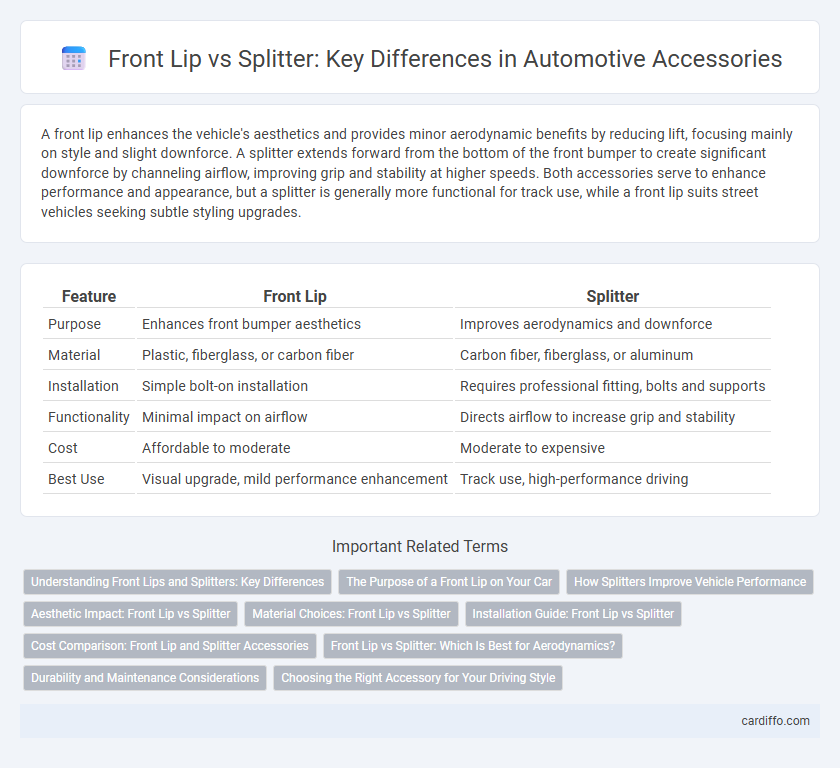A front lip enhances the vehicle's aesthetics and provides minor aerodynamic benefits by reducing lift, focusing mainly on style and slight downforce. A splitter extends forward from the bottom of the front bumper to create significant downforce by channeling airflow, improving grip and stability at higher speeds. Both accessories serve to enhance performance and appearance, but a splitter is generally more functional for track use, while a front lip suits street vehicles seeking subtle styling upgrades.
Table of Comparison
| Feature | Front Lip | Splitter |
|---|---|---|
| Purpose | Enhances front bumper aesthetics | Improves aerodynamics and downforce |
| Material | Plastic, fiberglass, or carbon fiber | Carbon fiber, fiberglass, or aluminum |
| Installation | Simple bolt-on installation | Requires professional fitting, bolts and supports |
| Functionality | Minimal impact on airflow | Directs airflow to increase grip and stability |
| Cost | Affordable to moderate | Moderate to expensive |
| Best Use | Visual upgrade, mild performance enhancement | Track use, high-performance driving |
Understanding Front Lips and Splitters: Key Differences
Front lips and splitters both enhance a vehicle's aerodynamics but serve distinct functions and designs. Front lips primarily improve aesthetic appeal and offer modest aerodynamic benefits by reducing front-end lift, while splitters are more performance-focused, extending forward from the bumper to increase downforce and stability at high speeds. Understanding these key differences helps in selecting the right accessory based on driving style and performance needs.
The Purpose of a Front Lip on Your Car
A front lip enhances your car's aerodynamics by reducing front-end lift and improving stability at high speeds. It also offers a subtle aesthetic upgrade, providing a sporty and aggressive look without the bulk of a full splitter. Designed primarily for street use, front lips balance style and function by improving airflow without compromising everyday drivability.
How Splitters Improve Vehicle Performance
Splitters enhance vehicle performance by increasing front-end downforce, which improves traction and stability at high speeds. By directing airflow underneath the car, splitters reduce lift and help maintain better tire contact with the road. This aerodynamic advantage results in improved handling and cornering precision.
Aesthetic Impact: Front Lip vs Splitter
Front lips enhance a vehicle's aesthetic by providing a subtle, sleek extension to the bumper, creating a refined and aggressive look without overwhelming the design. Splitters offer a more pronounced, race-inspired appearance by extending forward and emphasizing the car's width and stance, resulting in a bold, aerodynamic visual impact. Choosing between a front lip and a splitter depends on the desired level of visual aggression and styling intent for the vehicle.
Material Choices: Front Lip vs Splitter
Front lips are commonly crafted from flexible polyurethane or ABS plastic, offering impact resistance and ease of installation, while splitters typically use lightweight carbon fiber or fiberglass for superior aerodynamic performance and rigidity. Polyurethane front lips provide durability against minor scrapes, whereas carbon fiber splitters enhance downforce by maintaining structural integrity at high speeds. Material selection influences not only the visual appeal but also the functional benefits like weight reduction and resilience under track conditions.
Installation Guide: Front Lip vs Splitter
Front lip installation requires aligning the lip with the front bumper's lower edge and securing it using bolts, screws, or adhesive, often needing minimal vehicle modification for a straightforward fit. Splitter installation involves mounting brackets or supports under the bumper, potentially requiring drilling or reinforcement to ensure stability and optimal downforce performance. Properly following manufacturer instructions and using appropriate tools will ensure a secure and aerodynamic enhancement for both accessories.
Cost Comparison: Front Lip and Splitter Accessories
Front lips typically cost between $100 and $300, offering an affordable option for enhancing a vehicle's aerodynamics and appearance. Splitters are generally more expensive, ranging from $300 to $700 or more due to their more complex design and improved downforce capabilities. Choosing between a front lip and splitter depends on budget constraints and desired performance benefits.
Front Lip vs Splitter: Which Is Best for Aerodynamics?
Front lips and splitters both enhance vehicle aerodynamics by managing airflow and increasing downforce, but splitters typically offer superior performance due to their extended design that channels air more effectively under the car. Front lips primarily reduce front-end lift and improve high-speed stability, while splitters actively push the air downwards, maximizing grip and cornering capability. Choosing between a front lip and splitter depends on specific aerodynamic goals, track conditions, and vehicle setup, with splitters favored in racing for aggressive downforce and front lips preferred for everyday driving enhancements.
Durability and Maintenance Considerations
Front lips are typically made from flexible materials like polyurethane, offering moderate durability and easier maintenance due to their resistance to minor impacts and scratches. Splitters often use rigid carbon fiber or fiberglass, providing superior aerodynamic performance but requiring careful upkeep to avoid damage from road debris and environmental exposure. Choosing between the two hinges on balancing the need for durability with the level of maintenance effort one is willing to invest.
Choosing the Right Accessory for Your Driving Style
Front lips offer subtle aerodynamic benefits and enhance the aesthetic appeal of your vehicle, ideal for everyday driving and light performance use. Splitters provide more significant downforce by directing airflow beneath the car, making them better suited for high-speed track driving and aggressive handling. Selecting between a front lip and a splitter depends on your driving style, with front lips favoring style and mild performance, while splitters prioritize maximum aerodynamic efficiency.
Front lip vs Splitter Infographic

 cardiffo.com
cardiffo.com